|
|
(c) Copyright Patricia Dines, 2010. All rights reserved. |
There's a new brand of executive in town, and their favorite color is green. Bearing titles like chief sustainability officer (CSO) and director of sustainability, their vision stems from a passion for environmental and social responsibility. They work to help companies not only save money with increased energy and water efficiency, but also to identify new products and income streams, enhance brands, deepen customer loyalty, expand employee satisfaction, position their businesses competitively, manage resources responsibly, reduce liabilities -- and save the planet.
"We're blessed to be stewards of this place for this brief moment in time, and we take that responsibility very seriously."
-- Mike Benziger, winemaker and co-founder, Benziger Family Winery
Patricia Dines is a writer and public speaker. Her specialty is inspiring and empowering constructive action on environmental issues. For more information, see <www.patriciadines.info>.
